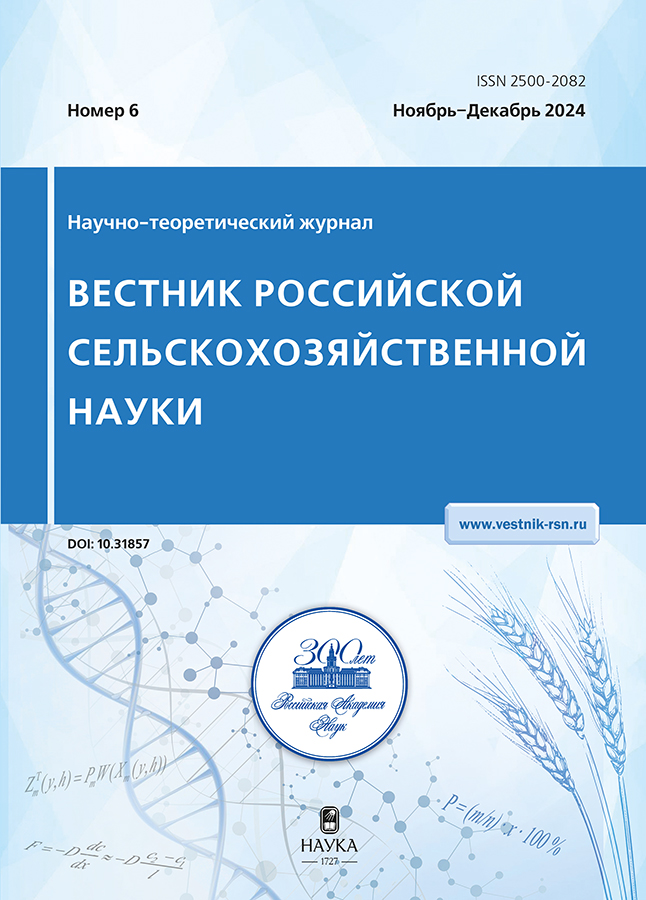Comparison of methods of DNA extraction from Hermetia illucens larvae
- 作者: Sutula G.I.1, Loskutov S.I.1, Sitnov V.Y.1
-
隶属关系:
- All-Russian Research Institute for Food Additives – Branch of V.M. Gorbatov Federal Research Center for Food Systems of RAS
- 期: 编号 6 (2024)
- 页面: 78-82
- 栏目: Новые технологии
- URL: https://vietnamjournal.ru/2500-2082/article/view/659230
- DOI: https://doi.org/10.31857/S2500208224060171
- EDN: https://elibrary.ru/WSVEOY
- ID: 659230
如何引用文章
详细
The black soldier fly (Hermetia illucens) is a promising and promising source of animal feed due to its high protein and fat content. For this reason, in 2023, by decision of the Government of the Russian Federation, it was included in the list of agricultural products. Currently, the active use of molecular genetic analysis methods for agricultural purposes continues, including for the study of feed and feed additives. However, today there is too little data in the domestic literature on their use against the black soldier fly. Thus, there is almost no information about DNA extraction methods – the very first stage of any genetic analysis. Thus, the purpose of this study is to compare the effectiveness of existing DNA extraction methods and adapt them to work with Hermetia illucens larvae. In this study, several DNA extraction methods were tested, based on different lysing (SDS, guanidine thiocyanate, CTAB) and chelating (EDTA) agents, as well as lysis durations (1, 2, 3 hours), in comparison with a commercial kit. As a result, it was found that the highest DNA concentration (750 ng/μl) is achieved using the CTAB method, however, when using this protocol, additional purification is necessary. The combined action of SDS and high concentrations of EDTA results in a lower DNA yield (50ng/µl), but does not require additional purification. For the first time, a method based on guanidine thiocyanate was used, which turned out to be quite relevant for this object of study. All of the above methods resulted in comparable or higher DNA yield compared to the commercial GMO-SORB-B kit. Increasing the lysis time to 3 hours when using methods based on guanidine thiocyanate and CTAB leads to increased DNA concentration.
全文:
作者简介
G. Sutula
All-Russian Research Institute for Food Additives – Branch of V.M. Gorbatov Federal Research Center for Food Systems of RAS
编辑信件的主要联系方式.
Email: capitals2016@yandex.ru
ORCID iD: 0009-0002-2781-9035
Junior Researcher
俄罗斯联邦, Saint PetersburgS. Loskutov
All-Russian Research Institute for Food Additives – Branch of V.M. Gorbatov Federal Research Center for Food Systems of RAS
Email: capitals2016@yandex.ru
ORCID iD: 0000-0001-9377-5515
PhD in Agricultural Sciences, Senior Researcher
俄罗斯联邦, Saint PetersburgV. Sitnov
All-Russian Research Institute for Food Additives – Branch of V.M. Gorbatov Federal Research Center for Food Systems of RAS
Email: capitals2016@yandex.ru
ORCID iD: 0000-0003-1927-1997
Director, V.M.Gorbatov Research Center for Food Systems
俄罗斯联邦, Saint Petersburg参考
- Calderón-Cortés N., Quesada M., Cano-Camacho H., Zavala-Páramo G. A Simple and Rapid Method for DNA Isolation from Xylophagous Insects // International Journal of Molecular Sciences. 2010. Vol. 11(12). P. 5056–5064. https://doi.org/10.3390/ijms11125056
- Chen M., Zhu Y., Tao J., Luo Y. Methodological comparison of DNA extraction from Holcocerrus hippophaecolus (Lepidoptera: Cossidae) for AFLP analysis // Forestry Studies in China. 2008. Vol. 10(3). P. 189–192. https://doi.org/10.1007/s11632-008-0035-5
- Dave N., Joshi T. A Concise Review on Surfactants and Its Significance // International Journal of Applied Chemistry. 2017. Vol. 13(3). P. 663–672. https://doi.org/10.37622/IJAC/13.3.2017.663-672
- Esser K.-H., Marx W.H., Lisowsky T. MaxXbond: first regeneration system for DNA binding silica matrices // Nature Methods. 2006. Vol. 3(1). https://doi.org/ 10.1038/nmeth845
- Gautam A. Phenol-Chloroform DNA Isolation Method. Springer International Publishing. 2022. P. 33–39. https://doi.org/10.1007/978-3-030-94230-4_3
- Green T.R., Popa R. Enhanced Ammonia Content in Compost Leachate Processed by Black Soldier Fly Larvae // Applied Biochemistry and Biotechnology. 2012. Vol. 166(6). P. 1381–1387. https://doi.org/10.1007/s12010-011-9530-6
- Sadykova E.O., Tyshko N.V., Nikitin N.S. et al. Monitoring methods for novel insect-derived food: the PCR protocol for the detection and identification of Hermetia Illucens insects based on the HEI-COI probe and primer system // Problems of Nutrition. 2023. Vol. 92(1). P. 36–44. https://doi.org/ 10.33029/0042-8833-2023-92-1-36-44
- Shehadul Islam M., Aryasomayajula A., Selvaganapathy P. A Review on Macroscale and Microscale Cell Lysis Methods // Micromachines (Basel). 2017. Vol. 8(3) P. 83. https://doi.org/10.3390/mi8030083
- Suganthi M., Abirami G., Jayanthi M. et al. A method for DNA extraction and molecular identification of Aphids // MethodsX. 2023. Vol. 10. P. 102100. https://doi.org/10.1016/j.mex.2023.102100
- Tan S.C., Yiap B.C. DNA, RNA, and Protein Extraction: The Past and The Present // Journal of Biomedicine and Biotechnology. 2009. Vol. 2009. P. 1–10. https://doi.org/10.1155/2009/574398
- Zheng L., Hou Y., Li W. et al. Biodiesel production from rice straw and restaurant waste employing black soldier fly assisted by microbes // Energy. 2012. Vol. 47(1). P. 225–229. https://doi.org/10.1016/j.energy.2012.09.006
补充文件














